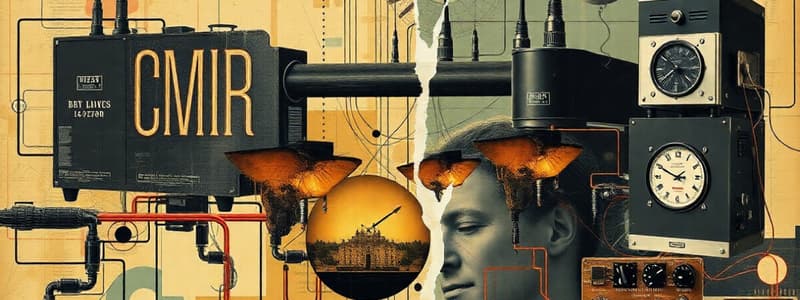Podcast
Questions and Answers
What does the term 'slew rate' in operational amplifiers indicate?
What does the term 'slew rate' in operational amplifiers indicate?
- It indicates the rate of change of the output voltage (correct)
- It represents the power consumption of the amplifier
- It measures the bandwidth of the amplifier
- It measures the speed of feedback loops
In a window comparator, how many voltage thresholds does it typically have for defining the desired input range?
In a window comparator, how many voltage thresholds does it typically have for defining the desired input range?
- Two (correct)
- Four
- One
- Three
Which operational amplifier configuration is most suitable for removing high-frequency noise from a signal?
Which operational amplifier configuration is most suitable for removing high-frequency noise from a signal?
- Inverting amplifier
- Active bandpass filter
- Active low pass filter (correct)
- Non-inverting amplifier
What is the purpose of compensation in operational amplifiers?
What is the purpose of compensation in operational amplifiers?
What is commonly used to perform mathematical operations such as addition and subtraction in operational amplifier circuits?
What is commonly used to perform mathematical operations such as addition and subtraction in operational amplifier circuits?
Which technology was primarily used in the early versions of operational amplifiers during their invention in the 1940s?
Which technology was primarily used in the early versions of operational amplifiers during their invention in the 1940s?
What is the effect of increasing the hysteresis in a comparator circuit?
What is the effect of increasing the hysteresis in a comparator circuit?
In a comparator with hysteresis, what is the term for the voltage difference between the rising and falling thresholds?
In a comparator with hysteresis, what is the term for the voltage difference between the rising and falling thresholds?
What is the term used to describe the point at which an operational amplifier becomes saturated and can no longer provide additional output voltage?
What is the term used to describe the point at which an operational amplifier becomes saturated and can no longer provide additional output voltage?
In which configuration is an operational amplifier most commonly used for voltage amplification?
In which configuration is an operational amplifier most commonly used for voltage amplification?
What does the term 'common-mode rejection ratio (CMRR)' refer to in the context of operational amplifiers?
What does the term 'common-mode rejection ratio (CMRR)' refer to in the context of operational amplifiers?
Which characteristic is typically true about the output of an operational amplifier operating in open-loop mode?
Which characteristic is typically true about the output of an operational amplifier operating in open-loop mode?
What is the primary purpose of a comparator in contrast to operational amplifiers?
What is the primary purpose of a comparator in contrast to operational amplifiers?
What type of feedback is hysteresis used for?
What type of feedback is hysteresis used for?
What is the purpose of the voltage offset adjustment in an operational amplifier?
What is the purpose of the voltage offset adjustment in an operational amplifier?
What is the ideal voltage gain of an operational amplifier in open-loop configuration?
What is the ideal voltage gain of an operational amplifier in open-loop configuration?
Flashcards
Op-Amp Saturation Point
Op-Amp Saturation Point
The point where an operational amplifier's output reaches its maximum or minimum voltage and cannot increase or decrease further.
Op-Amp Voltage Gain (Open Loop)
Op-Amp Voltage Gain (Open Loop)
The ratio of output voltage to input voltage in an operational amplifier without feedback.
Non-Inverting Op-Amp Configuration
Non-Inverting Op-Amp Configuration
An operational amplifier configuration where the input signal is applied to the non-inverting input terminal, resulting in an output with the same polarity as the input.
Common-Mode Rejection Ratio (CMRR)
Common-Mode Rejection Ratio (CMRR)
Signup and view all the flashcards
Op-Amp Open-Loop Output
Op-Amp Open-Loop Output
Signup and view all the flashcards
Comparator Purpose
Comparator Purpose
Signup and view all the flashcards
Hysteresis Feedback
Hysteresis Feedback
Signup and view all the flashcards
Instrumentation Amplifier Advantage
Instrumentation Amplifier Advantage
Signup and view all the flashcards
Slew Rate (Op-Amp)
Slew Rate (Op-Amp)
Signup and view all the flashcards
Window Comparator Thresholds
Window Comparator Thresholds
Signup and view all the flashcards
Active Low-Pass Filter
Active Low-Pass Filter
Signup and view all the flashcards
Operational Amplifier Compensation
Operational Amplifier Compensation
Signup and view all the flashcards
Common-Mode Rejection Ratio
Common-Mode Rejection Ratio
Signup and view all the flashcards
Differential Amplifier (Op-amp)
Differential Amplifier (Op-amp)
Signup and view all the flashcards
Comparator Propagation Delay
Comparator Propagation Delay
Signup and view all the flashcards
Comparator Hysteresis Effect
Comparator Hysteresis Effect
Signup and view all the flashcards
Study Notes
Operational Amplifier Concepts
- Saturation point: The point at which an operational amplifier becomes saturated and can no longer provide additional output voltage.
- Slew rate: Describes the rate at which the output voltage changes.
- Roll-off frequency: The frequency at which the amplifier's gain begins to decrease.
- Clipping point: The point at which the output voltage reaches its maximum or minimum value.
- Inverting configuration: Operational amplifiers are commonly used for voltage amplification in this configuration.
- Non-inverting configuration: Another common voltage amplification configuration.
- Differential configuration: Used for other applications, not typical for voltage amplification.
Common-Mode Rejection Ratio (CMRR)
- CMRR: Refers to the ability of an operational amplifier to reject common-mode signals.
- Common-mode signals: These signals are present at both input terminals of a differential amplifier.
- Rejecting common-mode signals: This is a crucial aspect of op-amp design and performance.
Open-Loop Mode Output Characteristics
- Linear and predictable voltage comparison: The output of an amplifier operating in open-loop mode isn't typically linear and predictable.
- Continuous average response: Also not typical
- Digital signal: Not a characteristic of open-loop behavior.
- Rapid switching: Not a typical characteristic.
Comparator Purpose
- Comparator's role: Unlike op-amps, comparators primarily switch between high and low states.
- Mathematical integration/differentiation: These are not the comparator's primary function.
- Linear amplification: Comparators do not perform linear amplification.
Hysteresis Feedback
- Hysteresis: Used to reduce the speed of an operational amplifier.
- Speed Reduction: It's a function of its use in feedback circuits, not the underlying component characteristic.
Voltage Offset Adjustment
- Noise reduction: A voltage offset adjustment can reduce the effect of noise.
- Bandwidth increase: Another possible outcome (not always the case).
- Threshold reduction: Reducing the threshold is not the principal outcome.
Instrumentation Amplifier Advantages
- High common-mode rejection ratio (CMRR): Critical for reducing interference and noise in signal processing applications.
- High input impedance: This is crucial to minimizing loading effects on the signal source.
- Low power consumption: A desirable feature in many applications.
- Low output impedance: This minimizes signal loss when driving other parts of a circuit.
Non-Inverting Comparator Output
- Input voltage greater than reference voltage: Results in a high output state.
- Other conditions: Not applicable to this specific comparison.
Signal Amplifier Component
- Amplifier: Designed to increase the amplitude of a signal.
- Inductor: Not designed for this function.
- Modulator: Not directly related; it affects signal characteristics but not strictly for amplitude alone.
- Capacitor: Not primarily for signal amplitude increase.
Open-Loop Voltage Gain
- Ideal voltage gain: Infinite voltage gain is a theoretical ideal for open-loop operation.
Operational Amplifier (Op-Amp) Purpose
- Mathematical operations: This was a primary historical driver for their design.
Op-Amp "Slew Rate"
- Output voltage change rate: This term indicates the rate at which the output voltage can change.
- Bandwidth: Not the primary definition; though they are related.
- Power consumption: Also related, but not its main function.
- Speed of loops: Related to feedback loop behavior but not the defining characteristic of slew rate.
Window Comparator Thresholds
- Multiple voltage thresholds: Used to define ranges in the comparator input.
High-Frequency Noise Removal Configuration
- Active low pass filter: A method of removing high-frequency noise from signals.
Operational Amplifier Compensation
- Stabilizing high frequencies: An integral part of op-amp design to avoid oscillations and instability at higher frequencies.
Common Mode Rejection Ratio Definition
- Ideal op-amp input impedance: The common-mode rejection ratio (CMRR) is not defined in this way.
Output Impedance (Operational Amplifier)
- Input impedance (Zin) or output impedance (Zout): Values for ideal operational amplifiers or in specific implementation circumstances like open loop mode.
Propagation Delay
- Delay change in input-output: The term measures the delay between a change in input and output.
Differential Amplifier Configuration
- Inverting and non-inverting uses: Preferred configuration for applications requiring both inverting and non-inverting amplifications.
Operational Amplifier (1940s) Technology
- Vacuum tubes: Used predominantly in early implementations.
Comparator in Zero-Crossing Detector
- Comparing input voltages: The role is to compare input voltages and determine when they cross zero.
- Square wave generation: A possible outcome of using it in the correct circuit design.
Hysteresis Effect in Comparator
- Stability and increased immunity: Increasing hysteresis can widen the input range for stable operation and immunity to signal noise.
Studying That Suits You
Use AI to generate personalized quizzes and flashcards to suit your learning preferences.




